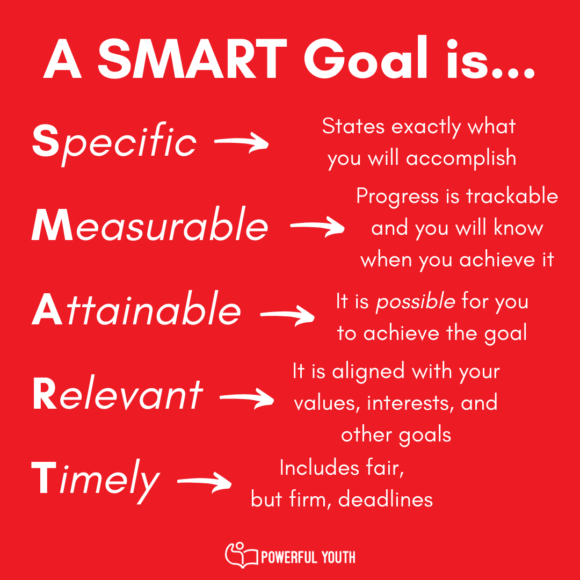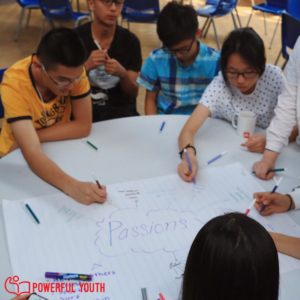Are trying to get into your dream college? Start a new club at school? Develop a community project that will make a difference? Hoping to make the varsity team next year? Or maybe get an A in chemistry? Regardless of what your goal is or how big it is, if you’re a young person who wants to accomplish something and is looking for the most efficient way to make it happen, you’ve come to the right place. And if you’re asking yourself, “What is a SMART goal? What in the world is WOOP?”, this guide to goal setting for teens is definitely for you!
Goal Setting : Why does it matter?
You’ve got a goal in your mind. You know what you want to achieve. Congratulations, you’ve completed the first step! Unfortunately, that might be the easiest step of them all when it comes to goal setting. Don’t worry, we’re here to help you along the way!
Goal setting is more than just coming up with an idea for what you want to happen, then trying to achieve it. Goal setting has been studied since 1935, and there is a mountain of research and books that you could turn to to try to understand how to set and achieve goals. But that’s for another day!
Ultimately, goal setting theory says that the best way to stay motivated and be successful is to set goals, but the TYPE of goals you set (and the way you set them) matters to whether you will achieve them. Not all goals are created equal! One thing that is pretty universally agreed upon by goal setting and success experts is that just thinking “hey, I want to do ____” is not maximizing your chances of following through and being successful upon that goal. And so, with that, let’s dive in to some of the top theories and approaches we think are important when it comes to goal setting for teens…
The Grandpa : Locke & Latham’s goal setting theory
Locke (and later, together with his collaborator Latham) first published his groundbreaking goal setting theory in 1968. This research completely changed the idea that setting relatively easy-to-achieve and general goals boosts motivation and morale. For example, “get good grades.” Instead, Locke & Latham stressed the importance of specific and measurable goals, as well as challenging goals. Essentially, shoot for the stars, but not just for any star, that one star over there specifically.
The five principles of effective goal setting that Locke & Latham proposed are as follows…
- Clarity: The goal needs to be straightforward, clear, and obvious to even outsiders.
- Challenge: Easy goals don’t provide enough motivation to work hard. Design a challenging goal, but one that is still attainable. It’s a fine balance!
- Commitment: Are you (and anyone else involved in achieving the goal) convinced that achieving this goal is important?
- Feedback: An effective goal is a goal in which you can assess your progress along the way, give feedback, and change course if need be.
- Task complexity: Highly complex goals can be overwhelming, often goals within goals within goals. Your goal should be manageable, without too many things going on within it.
If all that seems a bit complicated and hard to actually apply, you’re not alone. Goal setting for teens should be something you can implement as a regular part of your life (you’re so busy already!) with an easy-to-follow formula for success. Keep reading!
The Big Leagues : SMART Goals
When it comes to goal setting, SMART goals are the top dog. This well established tool for goal setting is used by almost every major company out there. If there’s one tool for goal setting for teens to understand, it’s this one. You’ll probably encounter it later on in university or your career as well too! This tool is what we use in our Global Leadership Academy, and it has helped our participants get some incredible community projects off the ground!
SMART is an acronym that can be used to easily build and assess your goals to see if they are effective. The criteria of a SMART goal is highly influenced by Locke and Latham’s goal setting theory, but in a package that is much easier to implement for anyone, anywhere. When creating a SMART goal, here’s what you need to consider…

“Okay, I get that… but what does that actually look like?” Don’t worry, we’ve got examples.
A high school student wants to start an environmental club at school. “Start an environmental club at school” is NOT a SMART goal. But, “start an environmental club with 20+ members and implement 3+ environmental initiatives implemented in the school by end of the school year to share my passion for the environment” – now THAT is a SMART goal!
Let’s break it down…
It’s specific: Even as an outsider, I know exactly what this person wants to accomplish. If I want to support them, it will also be easier for me to help them achieve this goal because I understand it!
It’s measurable: “20+ members” and “3+ environmental initiatives implemented in the school” makes it easy to track progress. If they have been working hard and have 15 members and 2 initiatives implemented, they know exactly what they still need to do to accomplish their goal.
It’s attainable: This person goes to a school that allows student-run clubs, and they have enough time in their busy schedule to start a club and take on environmental initiatives. It might be hard work, but it’s possible!
It’s relevant: Why is this person choosing this goal? Because they want to share their passion for the environment, and they attend a school without an environment club or environmental initiatives. It is relevant to them!
It’s timely: This person set a reasonable deadline for their goal – the end of the school year. It makes sense for the goal, because there is no school during the summer, and gives enough time to be possible and yet not SO much time to be unmotivating and forgotten about.
The Upstart : the WOOP tool
New on the big stage of goal setting, but backed by 20+ years of research, is the WOOP goal setting tool. It combines positive thinking with envisioning and planning for obstacles along the way. This tool help you develop small goals (<30 day timeline) you can take action on and achieve. It’s a great alternative to SMART goal setting for teens who want to integrate the power of goal setting into their daily lives in a quick and easy way. It’s tried and testes by our Global Leadership Academy participants, who found it very effective for their short-term goals! This 3-minute video does a great job explaining WOOP goals, and why they work…
Let’s use the same example as we did before – a high school student wants to start an environmental club – but using the WOOP model instead. WOOP goals are generally smaller goals with a timeframe of 1 day or 30 days that can be combined to achieve larger goals, so we will adjust our goal accordingly.
W (Wish) “What is your wish, a wish that is challenging, but feasible?” – I want to start a environmental club at my school and recruit 20 students to join.
O (Outcome) “What would be the best outcome of fulfilling your wish?” – That others discover a passion for the environment too.
O (Obstacle) “What is your main INNER obstacle that stands in the way of you fulfilling your wish?” – My concern that no one will care about the cause enough to join.
P (Plan) “What can you do to overcome your obstacle?” – I can make posters illustrating the environmental impact of the school (overflowing garbage bins, cars idling during pick-up time, …) to convince students to want to make a difference.
The creators of WOOP have a website with a lot more information about the effectiveness of WOOP goals and how to use them in your life, but even better, they have a free app available in 13 languages on both iPhone and Android! The app allows you to be guided though setting WOOP goals (you can also do this interactively on their website), and you can track your progress too!
The Heart of It : Passion

Beyond the approaches to goal setting for teens that we’ve talked about above, there is something else that we believe are important to mention before you embark on this journey.
We at Powerful Youth believe that much of the power that EVERY youth has to make a difference comes from passion. At our Global Leadership Academies in Canada and the UK, we help youth to discover their passions and coach them use that passion to make change in their communities and work towards their goals. By considering your passions when setting goals (no matter what approach you take), you can establish goals that you will feel driven to accomplish.
Discovering your passions can be a lifelong journey for many, but an easy question you can ask yourself to start considering your passions is just this…
“What am I willing to work hard at for no reason beyond personal enjoyment and my own sense of accomplishment?”
For some, this may be a sport or hobby they enjoy, or for some, it may be an interest or topic they just can’t get enough of and maybe research or study in their own time. If you can find a way to incorporate your passions into your goals, it will increase your motivation to work hard and achieve them!
For the example we have been using – the high school student who wants to start an environmental club – their passion for the environment is a key part of the goal! Even if part of the reason behind their goal is to add an extra line to their college application, incorporating their passion for the environment into this will increase their motivation and likeliness to accomplish it. They could also boost their college application by starting a different kind of club, but if that isn’t their passion, they will be less likely to follow through with it.
Passion is also highly infectious. If your goals are fueled by your passions, it will be much easier to convince others to join or support you. You can hear passion in the voices and see passion in the actions of successful leaders of all types from around the world!
Further inspiration…
Here are a few of our favorite goal-related quotes to help inspire those first steps of a journey into goal setting for teens with big ideas and big goals!
“A goal without a plan is just a wish.” – Antoine de Saint-Exupéry
“This one step – choosing a goal and sticking with it – changes everything.” – Scott Reed
“A goal should scare you a little and excite you a lot.” – Joe Vitale
“Our goals can only be reached through a vehicle of a plan, in which we must fervently believe, and upon which we must vigorously act. There is no other route to success.” – Pablo Picasso
—
Using the power of experience-based learning, Powerful Youth is an award winning social enterprise dedicated to providing the best leadership training for youth world wide, helping them uncover purpose, fueled by their passions, to create positive and lasting change in themselves and their communities.
Want to learn more about our experiential leadership programs in Canada and the UK for international youth ages 12-18?
